Passion fruit plants, scientifically known as Passiflora edulis, hold a world of intrigue in their propagation and trellising methods. With mesmerizingly intricate flowers, these captivating vines are more than just a treat for the eyes – they’re a lesson in botanical finesse. Delving into the art of propagation, we unravel the secrets of nurturing these vines from seeds or cuttings. But that’s not all – brace yourself for a journey through trellising techniques that elevate these plants to new heights, ensuring optimal sun-kissed fruit bearing.
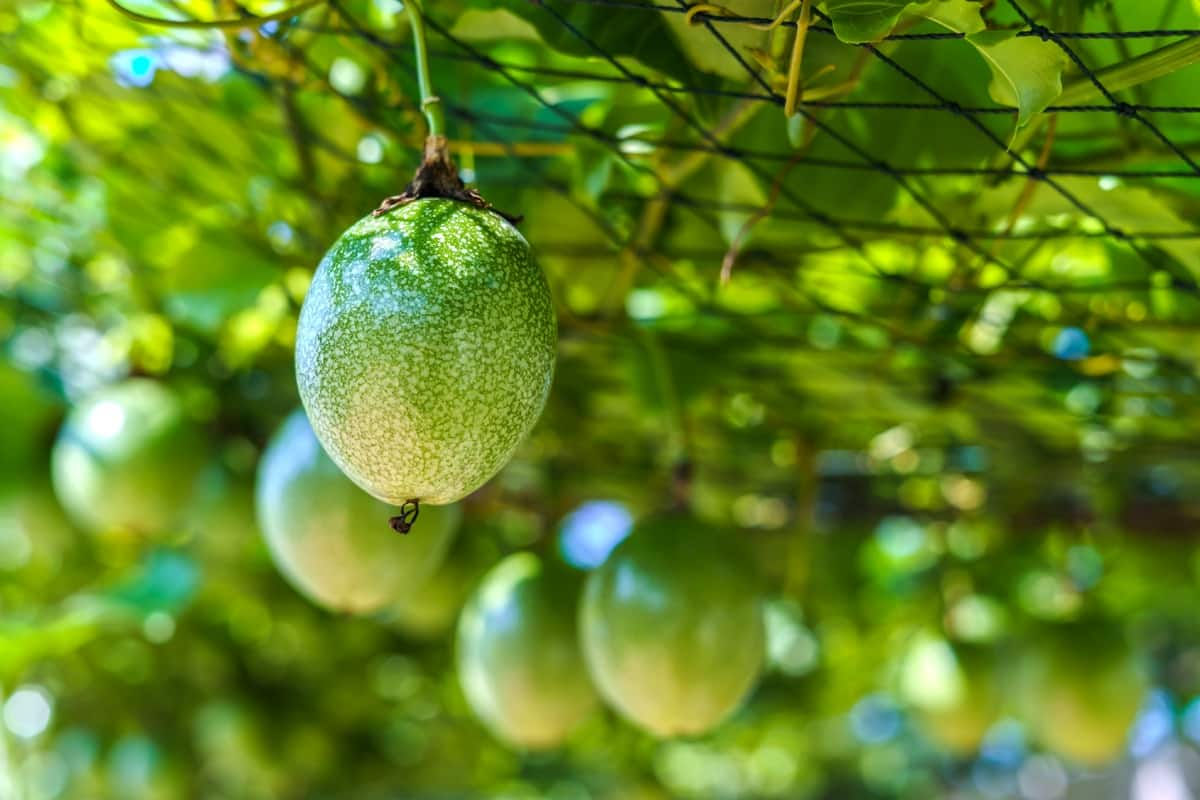
Propagation and Trellising of Passion Fruit Plants
Introduction to Passion Fruit
The passion fruit (Passiflora edulis), belonging to the Passifloraceae family, originates from Brazil and thrives in diverse regions of India, like the Western Ghats and Himachal Pradesh. Renowned for its robust flavor and aroma, this Fruit elevates squash quality and enriches various products.
Its nutritious, delightful juice is harmoniously combined with pineapple, mango, and ginger juices for culinary creations. The Fruit boasts Vitamin A and essential minerals, making it an invaluable resource. With its fragrant flowers and distinctive fruits, the vine holds a mesmerizing allure. Extracts from leaves and rinds offer medicinal, nutritional, and industrial prospects. Passion fruit’s botanical marvel continues to captivate industries worldwide.
Seed Propagation of Passion Fruit Plants
Passion fruit propagation through seeds. This method, widely embraced for ornamental and commercial purposes, boasts popularity. Passion fruit seeds exhibit unique behavior in propagation, with germination rates ranging from 70-85%. The success lies in using fresh seeds, either directly post-harvest or within a window of 3-6 months.
Optimal conditions involve moist storage in shaded environments, followed by sowing at a depth of 1 cm. Depending on the passion fruit variety, germination spans 1-2 weeks to 3 months, accelerated by a warm 30°C (85°F) climate. Enhancing germination involves pulp removal and gentle drying at room temperature.
A seed coat nick and overnight soaking promote sprouting for more challenging cases. Once germinated, nurturing seedlings in shaded individual pots, gradually acquainting them with sunlight, sets the stage. These young plants, reaching 25-40 cm in height, can be transplanted after three months for a flourishing journey into the open field.
Cutting Propagation of Passion Fruit Plants
This method involves harnessing the vitality of healthy and prolific mother plants to generate new growth. The process entails selecting semi-hardwood cuttings during the plant’s active growth phase, featuring 2 to 4 nodes. Prudent removal of all leaves except those at the top paves the way for successful propagation.
In case you missed it: Top 15 Steps to Boost Passion Fruit Yield: How to Increase Passion Fruit Production, Quality, and Size
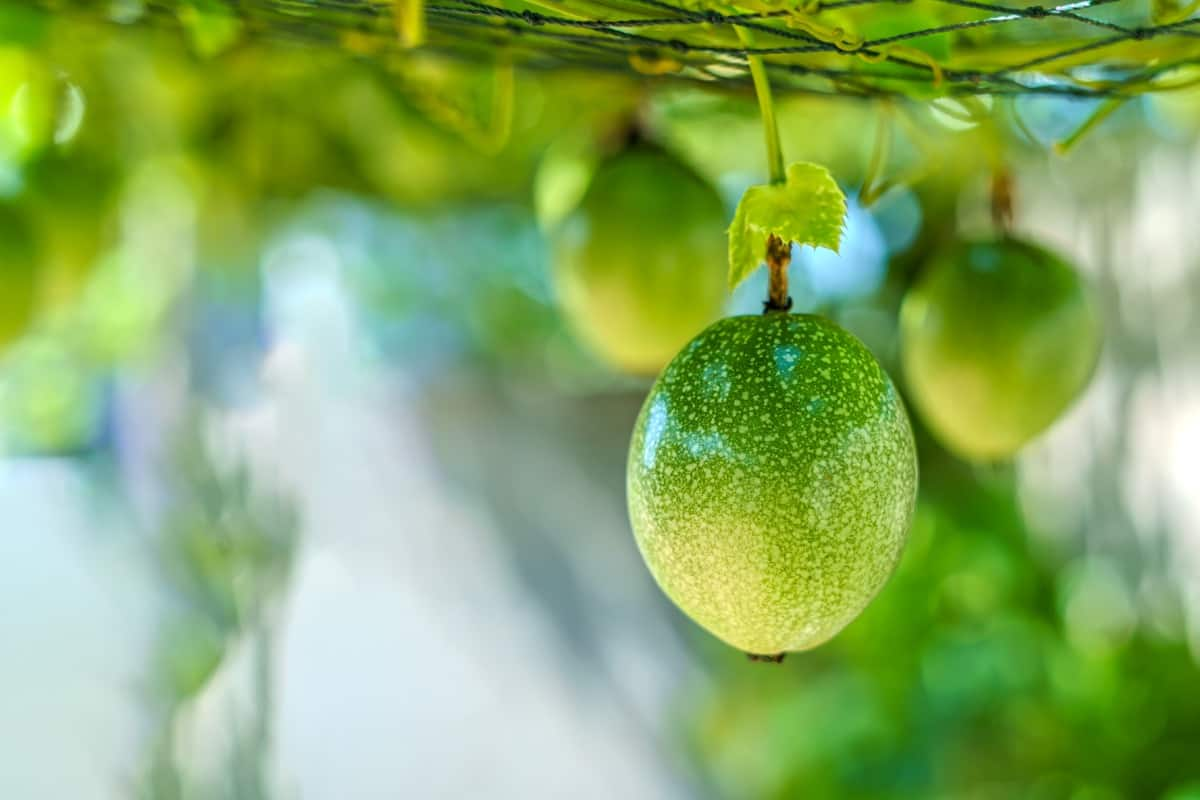
To amplify success, a touch of the rooting hormone can grace the cutting’s bottom 5-10 cm. Placing the lower two-thirds of the cutting within a suitable growth medium, options like porous soil, black or beach sand, sawdust, vermiculite, and wood shavings beckon. The cuttings find comfort in warm, humid spaces until their roots take hold. At a 15-16 cm height, rooted cuttings are poised for transplantation into the field.
Grafting Propagation of Passion Fruit Plants
Grafting for passion fruit propagation. Grafting is a straightforward technique, offering the advantage of early fruiting and predictable variety outcomes. This method securely perpetuates parent plant traits and desired fruit qualities, underscoring its efficacy.
Advantages of Grafting
- Accelerated fruit-bearing in grafted trees.
- Grafted passion fruit vines sprawl, unlike the vertical growth of seedlings.
- Manageably shorter grafted vines enable convenient harvesting, spraying, and other tasks.
- Grafted vines retain sought-after traits, notably fruit quality, from parent plants. Typically, yellow passion fruit rootstock hosts purple passion fruit grafts, yielding enhanced fruit quality, drought resistance, nematode resilience, and disease tolerance.
For effective grafting, stock and scion should stand at about 45 cm (18 in.) height with pencil-thick stems. Scions, around 8-10 cm (3-4 in.) long and bearing two nodes, complement this. A 25-30 cm (10-12 in.) stock cut above the soil line is essential. Wedge, side, T, and whip grafting styles abound, with a wedge graft example provided. Requirements comprise a one-year-old passion fruit vine seedling, a scion with a prominent bud, sharp cutting tools, a 5-inch black plastic pouch with a hole, and grafting tape for secure attachment.
A slanting cut is made through the scion base in the grafting process, matched by a corresponding stock stem cut. These surfaces are united, secured with grafting tape, and enclosed in a plastic bag to preserve optimal moisture and temperature. Once sufficient leaves flourish on the grafted plant, the tape can be loosened and lower shoots removed. Planting the new specimen becomes viable once the shoot leaves mature.
In case you missed it: Best Plants to Grow Under Grow Lights in Hydroponics: For Flowers, Herbs, Vegetables, and Fruits
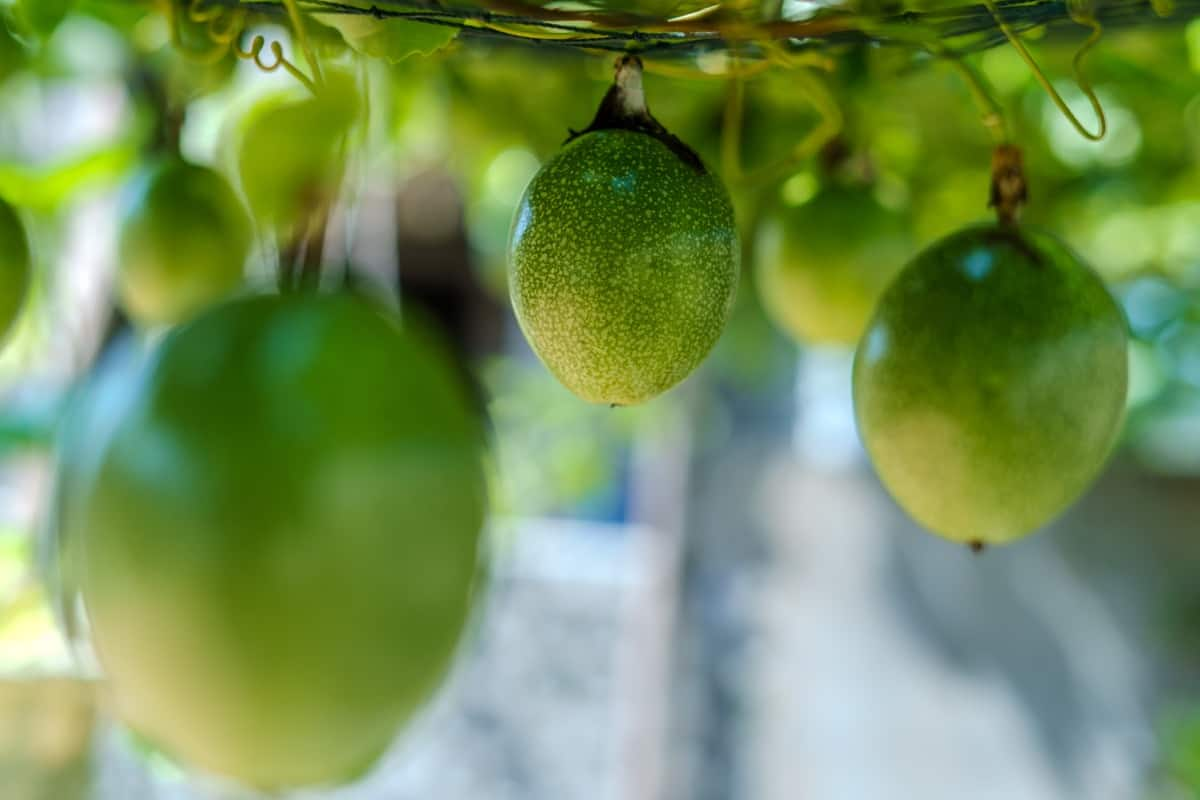
Air Layering Propagation of Passion Fruit Plants
Air layering involves strategically encouraging roots to form on a branch while still attached to the parent plant. This technique is useful for plants that are hard to propagate through other means. The method begins by selecting a healthy and vigorous branch. A section of the bark is removed, and a rooting hormone may be applied to stimulate root growth.
This area is then covered with a moist medium, often using sphagnum moss. The moist environment encourages the growth of roots. Once the roots have developed sufficiently, the branch can be cut below the root section and planted as a new individual plant.
Division Propagation of Passion Fruit Plants
Division propagation is a simple method for propagating passion fruit plants. It involves splitting an established plant into smaller sections, each capable of developing into an independent entity. This process ensures the continuity of desirable traits, makes the plants self-sufficient, and simplifies the replication of parent plant traits.
Passion fruit division propagation involves extracting a mature plant from the ground, gently dividing it into sections, and replanting them to encourage growth into robust vines. The best time for division is during the plant’s dormant period or the beginning of the growing season. Carefully extract the plant without damaging its roots, and separate the segments into sections, ensuring each has roots and shoots. After division, the segments are ready for replanting in well-draining soil and a suitable planting location.
Importance of Proper Trellising for Passion Fruit Plants
- Enhanced Sunlight Exposure: A well-designed trellis ensures each leaf basks in the sun’s embrace, fuelling photosynthesis and nurturing robust growth.
- Optimal Air Circulation: Passion fruit vines, akin to dancers, need space to breathe. Adequate spacing through trellising mitigates disease risks and promotes a healthier ecosystem.
- Efficient Harvesting: Picture a garden of treasures within easy reach. Trellising facilitates effortless fruit picking, sparing you the acrobatics.
- Maximum Fruit Production: A harmonious balance between vines and trellis yields bountiful Fruit. With proper support, passion fruit plants shower you with their flavorful gifts.
- Space Utilization: Vertical growth means more space for other flora. Trellised passion fruit plants make the most of your garden’s canvas.
- Aesthetic Appeal: Trellised vines create an enchanting landscape, captivating eyes with their artistic arrangement.
In case you missed it: High-Density Dragon Fruit Plantation: Spacing, Plants Per Acre, Techniques, Cost, and Yield
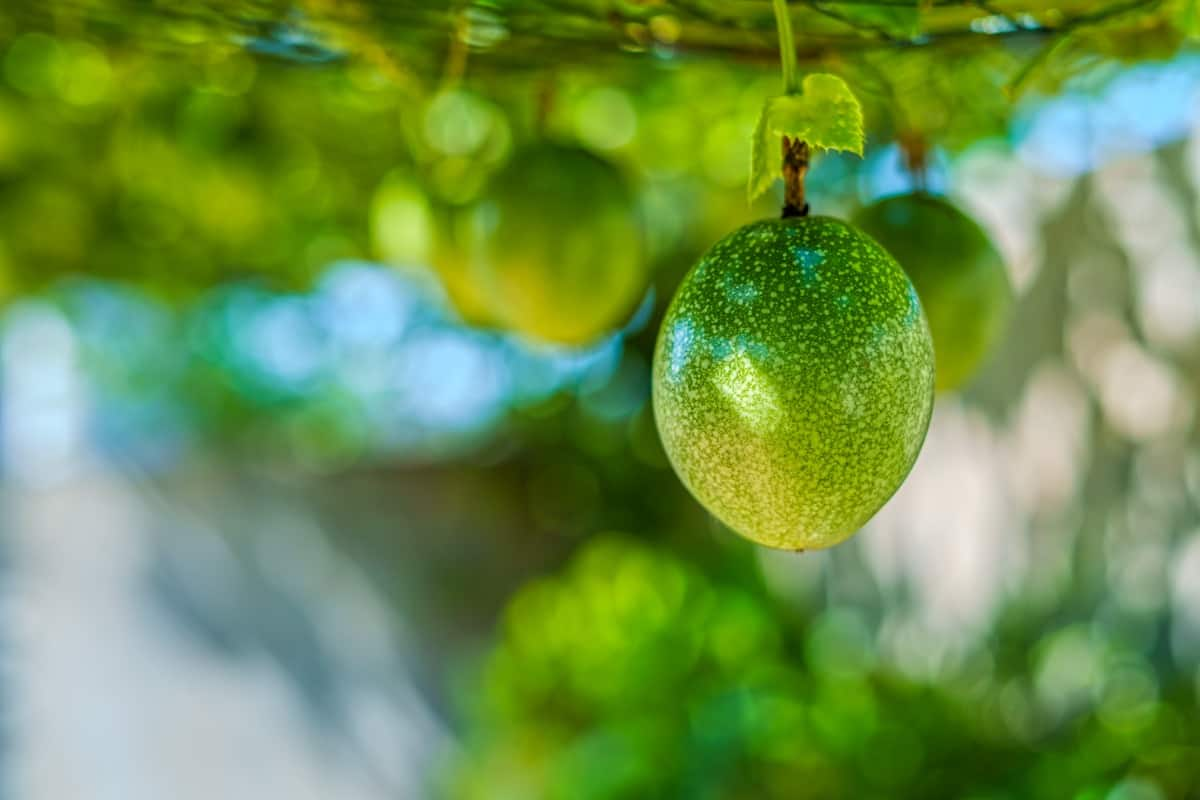
Types of Trellises for Passion Fruit Plants
- Ideal Orientation: Imagine the trellis as a compass guiding the vines. Position it north-south to maximize sunlight exposure, ensuring vibrant growth. In windy zones, align it parallel to the wind’s path, ensuring stability.
- Variety of Systems: Trellising presents a canvas of options. Among them, the T-type system shines. Its cross arm and 2-4 horizontal wires atop each post provide a sturdy haven for your vines.
- Strong Foundation: Visualize the trellis as a fortress. Employ no. 9 or 10 galvanized steel poles and wires, resilient enough to bear the weight of the vines even during bountiful years and strong winds.
- Height Matters: Envision poles as vines’ skyscrapers, reaching up to 7 m (15 ft.) high. A substantial portion (45-75 cm or 18-30 in.) must be anchored underground. Wooden poles, treated with preservatives, withstand termites and weather, prolonging their life.
- Strategic Spacing: Imagine vines and trellis poles in harmony, a synchronized dance. The spacing directly corresponds to optimal production. Usually, two plants thrive between poles (0.6-2 m or 2-6.5 feet apart). In fruitful years, extra poles support the lush canopy and wires between existing poles.
Designing and Constructing a Trellis for Passion Fruit Plants
Optimal orientation is north-south for maximum sun exposure, while alignment parallel to prevailing winds prevents damage. The T-type system proves effective with a cross arm and 2-4 horizontal wires atop each post. Utilize galvanized steel poles (no. 9 or 10) and wires to withstand plant weight and environmental challenges.
Poles reaching up to 7 m (15 ft.) must be partially buried (45-75 cm or 18-30 in.) and treated against termites. Spacing is vital, typically accommodating two plants between 0.6-2 m (2-6.5 feet) apart. In prolific years, supplementary poles provide support for the canopy and wires.
Training and Pruning Techniques for Passion Fruit Plants on Trellises
Training and pruning are crucial for passion fruit plants on trellises to ensure yield control and plant support. Flawed trellis construction can lead to sagging and vine loss. Training vines to a single unbranched shoot, allowing two vigorous shoots to grow in opposite directions from the midpoint.
Laterals from primaries hang downward, forming the potential fruit-bearing area. Regularly remove interfering tendrils. Trellis methods include 2.5 m posts with 9-11 gauge wires, wooden posts with coaltar, a telephone system for intercropping and weed suppression, and a trellis system for various regions. Pruning boosts new growth and consistently high yield.
In case you missed it: How to Get Rid of Fruit Fly in Vegetables: Symptoms, Treatment, Management, Chemical, and Organic Control
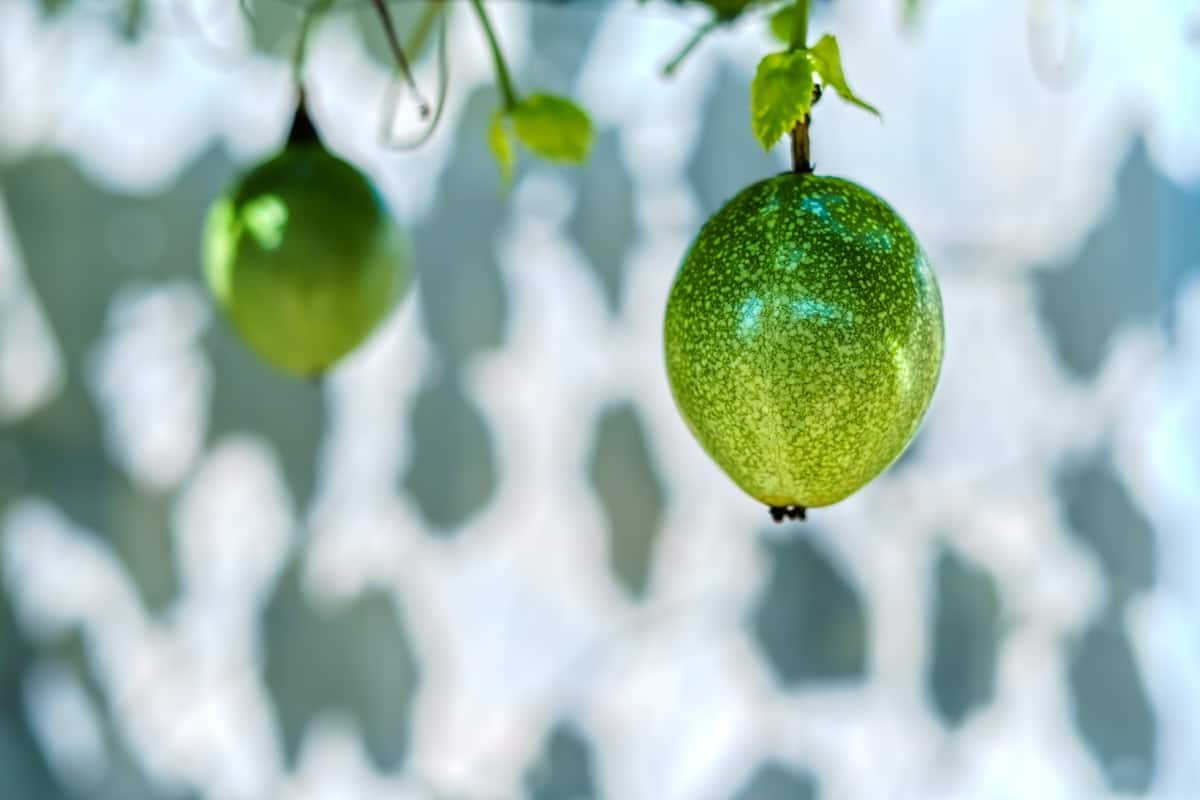
Benefits of Trellising in Passion Fruit Plantations
- Sunlight Optimization: Trellised vines are positioned for maximum sunlight exposure, nurturing robust growth and photosynthesis.
- Airs of Circulation: Adequate spacing enhances airflow, thwarting disease and creating a healthier plant microenvironment.
- Effortless Harvesting: Trellised plants simplify fruit picking, granting easy access to the vibrant bounty.
- Increased Yield: Trellises support vertical growth, leading to elevated fruit production and efficient space utilization.
- Easier Management: Pruning, pest control, and maintenance become more manageable, contributing to plant health.
- Enhanced Aesthetics: Structured vines form an appealing landscape, transforming plantations into picturesque vistas.
- Disease Reduction: Trellising minimizes soil contact, reduces the risk of soil-borne diseases, and promotes vine longevity.
- Space Efficiency: Vertical growth saves space, enabling diversification with intercropping and improving overall plantation efficiency.
Disease and Pest Management in Trellised Passion Fruit Plants
Pests
- Fruit Fly: Daucus sp. punctures developing fruits, causing deformities and reduced pulp content.
- Thrips: Thrips hawaiiensis Morgan feed on buds and fruits, leading to deformities, lower fruit weight, and juice content.
- Mites: Tetranychus neocaledonicus Andro damaged leaves and tender fruits, causing defoliation and undersized fruits.
Diseases
- Brown Spot Disease: Alternaria macrospora Simes causes concentric brown spots with greenish margins, leading to branch girdling and premature defoliation.
- Root Rot: Phytophthora nicotianae var. parasitica affects roots, causing plant death; drenching with a 1% Bordeaux mixture helps.
- Wilt or Collar Rot: Fusarium oxysporum/F.passiflorae leads to sudden plant death; resistant varieties or rootstocks are the main control methods.
Control Measures
- Neem-based pesticides/fungicides, like Azadirachtin, effectively control various pests and diseases.
- Biological insecticides like Verticel (from Verticillium lecanii) and Larvocel (Beauveria bassiana) combat thrips, mites, and aphids.
Harvesting Techniques for Trellised Passion Fruit Plants
Harvesting trellised passion fruit plants requires strategic timing and care. Fruit yield commences around ten months after planting, reaching its peak at 16-18 months. Fruiting spans two key periods: August to December and March to May. Maturation takes 80-85 days. Harvest slightly purple fruits, including a small stem portion.
Prompt marketing curbs weight loss and maintains appearance. While the rind wrinkles upon drying, the pulp remains intact for several days. Regarding yield, the purple variety averages 8-10 t/ha, while the hybrid Kaveri shines at 16-20 t/ha. On average, each vine offers 7-9 kg or 200-250 fruits annually.
Post-harvest Handling and Storage of Passion Fruits From Trellised Plants
After harvesting from trellised plants, passion fruit doesn’t find its place as a table fruit due to its numerous small seeds. However, its commercial value shines in processing – crafting juice, concentrate, squash, ice cream, and confectionery. Blending its juice with other fruit juices enhances flavor, commanding a strong demand, especially in foreign markets. Collaboration between NGOs, government bodies, and financial institutions has established a processing unit. A crushing capacity of 2 t/hour benefits farmers and the local economy.
In case you missed it: Key Rules to Get Rid of Fruit Fly in Guava: Symptoms, How to Treat, Management, Chemical, and Organic Control
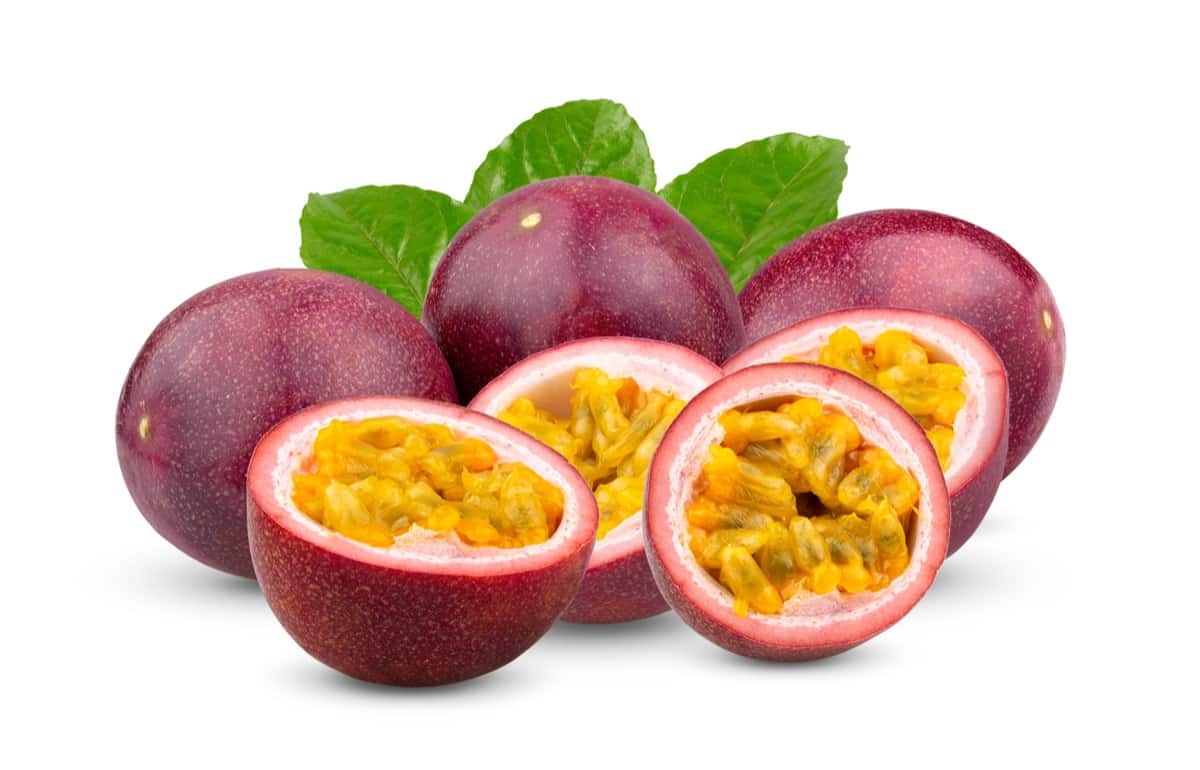
Economic Considerations and Profitability of Trellised Passion Fruit Plantations
Trellised passion fruit plantations hold economic considerations that shape profitability. The vine’s economic life spans five years; sustaining them beyond that isn’t cost-effective, despite the extended yield. Totals Rs. 100,600 per hectare over two years. Margin money ranges from 5% to 15%, with the current model using 10%.
An assumed 12% interest rate reflects RBI guidelines. Security follows RBI directives. Financial analysis reveals NPW of Rs. 74,876, BCR of 1.60:1, and IRR exceeding 50%, substantiating the model’s financial viability. Passion Fruit’s profitability story unveils through these economic nuances.
Conclusion
Passion fruit propagation and trellising, meticulous techniques shape thriving plantations. From diverse propagation methods to strategic trellis designs, a symphony of careful planning and execution harmonizes, yielding abundant fruits and a landscape rich with flavor and beauty.
- Modern Sheep Farming Technology: The Future of Sheep Husbandry
- Goat Farming Technology: The Future of Goat Husbandry
- How to Build a Low-budget Goat Shed: Cheap Ideas and Tips
- Goat Farming Training Programs in India: A Beginner’s Guide
- Types of Pesticides Used in Agriculture: A Beginner’s Guide
- Economical Aquaculture: A Guide to Low-Budget Fish Farming
- 15 Common Planting Errors That Can Doom Your Fruit Trees
- How to Make Houseplants Bushy: Effective Tips and Ideas
- Innovative Strategies for Boosting Coconut Pollination and Yield
- Pollination Strategies for Maximum Pumpkin Yield
- The Complete Guide to Chicken Fattening: Strategies for Maximum Growth
- Natural Solutions for Tulip Problems: 100% Effective Remedies for Leaf and Bulb-Related Issues
- Revolutionizing Citrus Preservation: Towards a Healthier, Greener Future
- Natural Solutions for Peony Leaf and Flower Problems: 100% Effective Remedies
- Maximizing Profits with Avocado Contract Farming in India: A Comprehensive Guide
- Natural Solutions for Hydrangea Problems: 100% Effective Remedies for Leaf and Flowers
- The Ultimate Guide to Choosing the Perfect Foliage Friend: Bringing Life Indoors
- From Sunlight to Sustainability: 15 Ways to Use Solar Technology in Agriculture
- The Ultimate Guide to Dong Tao Chicken: Exploring from History to Raising
- The Eco-Friendly Makeover: How to Convert Your Unused Swimming Pool into a Fish Pond
- Mastering the Art of Delaware Chicken Farming: Essentials for Healthy Backyard Flocks
- 20 Best Homemade Fertilizers for Money Plant: DIY Recipes and Application Methods
- How to Craft a Comprehensive Free-Range Chicken Farming Business Plan
- Brighten Your Flock: Raising Easter Egger Chickens for Beauty and Bounty
- How to Optimize Your Poultry Egg Farm Business Plan with These Strategies
- Subsidy for Spirulina Cultivation: How Indian Government Schemes Encouraging Spirulina Farmers
- Ultimate Guide to Raising Dominique Chickens: Breeding, Feeding, Egg-Production, and Care
- Mastering the Art of Raising Jersey Giant Chickens: Care, Feeding, and More
- Ultimate Guide to Raising Legbar Chickens: Breeding, Farming Practices, Diet, Egg-Production
- How to Raise Welsummer Chickens: A Comprehensive Guide for Beginners
- How to Protect Indoor Plants in Winter: A Comprehensive Guide
- Ultimate Guide to Grow Bag Gardening: Tips, Tricks, and Planting Ideas for Urban Gardeners
- Guide to Lotus Cultivation: How to Propagate, Plant, Grow, Care, Cost, and Profit
- Agriculture Drone Subsidy Scheme: Government Kisan Subsidy, License, and How to Apply Online
- Ultimate Guide to Raising Araucana Chickens: Breed Profile, Farming Economics, Diet, and Care
- Bringing Hydroponics to Classroom: Importance, Benefits of Learning for School Students